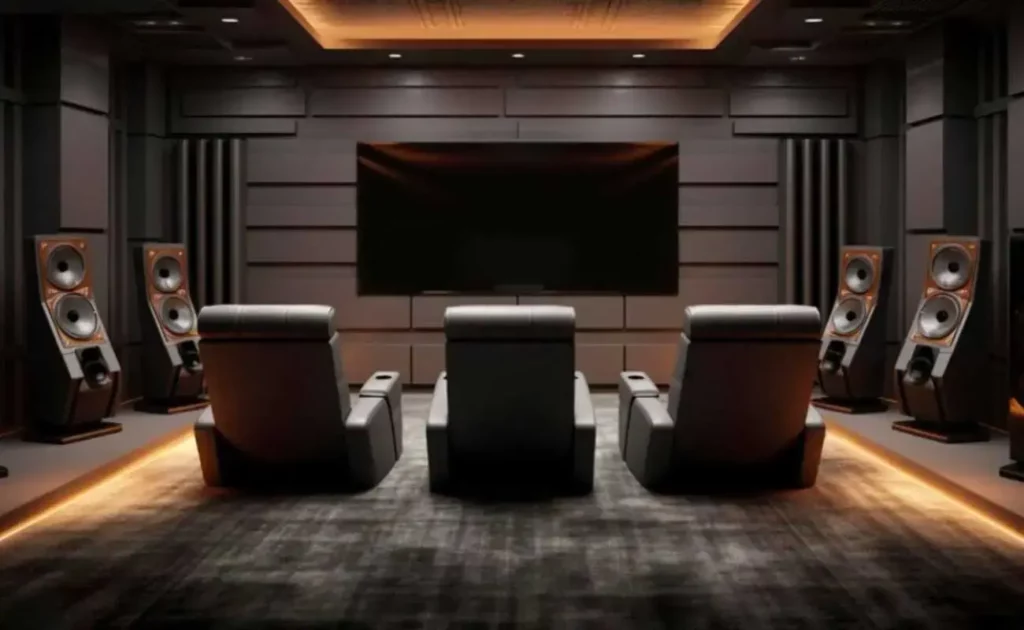The Ultimate Guide to Perfect Center Channel Speaker Placement!
Is your home theater system not just right? Are there some scenes where the speech is barely audible, or the sound seems to be out of sync with what is happening on the screen? Perhaps part of the problem lies in center channel speaker placement.
Your center channel is about much more than just dialogue delivery; it’s the foundation of your entire mix. If placed correctly, this speaker will turn your living room into an attractive home theater system.
AV design software can help you achieve optimal sound by:
- Know where to position the speakers for that particular type of room.
- Adjusting audio to optimize your gaming experience.
- Suggest the acquisition of new pieces of equipment.
Experience the difference XTEN-AV can make with our 15-day free trial. Open the possibilities of home theater entertainment today.
Key Takeaways
- Know how center channel placement is crucial for your home theater setup and how to align the speakers.
- Experiment with angling, toe-in, and speaker stands to achieve optimal sound quality.
- Utilize resources like XTEN-AV’s Ceiling Speaker Layout Tool to simplify setup and ensure the best audio experience.
AV Design Mastery + Winning Proposals = 10x Productivity!
- Automatic Cable Labeling & Styling
- 100+ Free Proposal Templates
- Upload & Create Floor Plans
- 1.5M Products from 5200 Brands
- AI-powered ‘Search Sense'
- Legally Binding Digital Signatures
No Credit Card Required
What is the Ideal Center Channel Speaker Placement?
Perfecting the center channel speaker placement requires careful consideration of many elements that will ensure that you achieve high-quality audio for your home theater.
Horizontal placement
Place your center channel right in front of your television set. The speaker should be ideally aligned flush with the front edge of your TV screen. This minimizes the distance that sound needs to travel from the screen to your ears, thereby maintaining the synchronism of audio with visuals for a beautiful experience.
Vertical placement
Ear level:
This is the optimal positioning for your center channel’s tweeter—to be at the same height as your ears when seated in your primary listening position. A cluttered, yet natural, soundstage is achieved by elevating the center speakers to such a level that it feels like the dialogue is actually coming from the actors on the screen.
Above or Below the TV:
- If placing the speaker at ear level is just not feasible given your TV stand or furniture configuration, consider installing the center channel directly above or below the TV.
- Make sure, if placed above, to angle the speaker toward your primary listening position. If placed below, angle it slightly up.
Behind an Acoustically Transparent Screen (Projection systems):
When using a projector and acoustically transparent screen in a home theater system, the optimal placement location for the center channel is center horizontally — behind the screen and at ear level vertically. This placement provides perfect integration of audio and an extremely lifelike visual.
What Affects Your Center Speaker Placement?
The ideal placement guidelines are a great starting point, but several factors can influence your center speaker placement. It’s essential to consider these factors to tailor the placement to your specific setup and room characteristics.
Room Size and Layout:
A lot will depend on the dimensions and layout of your room and how that interacts with the sound reflections in it. Larger rooms may call for angling the speakers more or in a bit of toe-in, perhaps, or maybe doing them in at an angle to get the best sound dispersion. Also, furniture, rugs, and whatever else in the room may change the way sound waves respond in your space and may dictate some additional tweaks to the in-ceiling speaker placement of your center channel.
Furniture Constraints:
Your TV stand could limit your placement options for the entertainment center. If you have a limited amount of space under your television, you might want to consider wall-mounting your center channel or placing the speaker on a stand so you can adjust it to the perfect center channel speaker height. Sometimes, due to a space crunch, you may have to choose a smaller center channel speaker that fits space requirements.
Speaker Size:
There are a variety of sizes offered for center channel speakers, and the dimensions could determine where someone might place their speaker. Bigger speakers will not fit every place one might want to set them, whereas smaller ones sometimes allow for more options. Be sure to choose a speaker that matches your other speakers and fits into your available space.
Listening Distance:
The distance from your listening position to the speaker in the center channel is what brings about the perceived soundstage and dialogue clarity. You may often find this making you raise the volume of the speaker. You could also try to angle it just a little in case you are sitting far away from the TV.
Personal Preference:
Ultimately, the best placement for your center channel speaker is the one that sounds best to your ears. Do feel free to experiment with pivotal positions that would place the dialogue at an easier-to-hear volume level while balancing with other sound from the left and the right.
What are the Ways to Address Most Common Center Channel Speaker Placement Problems
Every home theater speaker placement is not perfect, so chances are that you will have to deal with some imperfections when trying to get it right. Here are some common things you will face when it comes to center speaker placement problems:
No Room Below the TV:
If your TV stand or entertainment center doesn’t provide space below the TV for the center channel, consider these alternatives:
Wall Mounting:
Many center channel speakers have built-in keyhole slots or mounting points, facilitating easy insertion onto the wall. This can be great if you need to save room space while continuing to place them at ear level.
- Speaker Stands: Speaker stands can be height and angle adjustable. You would get stands that would easily blend in with the rest of your decor and your existing setup.
- Ceiling Mounting: In some cases, a mountable center channel speaker might be a good idea to sacrifice the aesthetics of the stand of the TV or the walls. Just tip up the speaker towards the direction of listening for perfect sound delivery.
Limited Space:
Smaller rooms or limitation of space on the TV stand will need little acrobatics:
- Compact Center Channel: If you have an entertainment center with little space on the shelves, consider the compact center channel speakers. Most manufacturers make smaller models without compromising in the sound quality.
- In-Wall Speakers: With their sleekness and space-saving feature, in-wall speakers are one of the best solutions, especially in a small room. They mount flush into your wall, which takes away visual clutter and, in turn, gives you maximum floor space. However, if you want to know in-depth about how in-wall and in-ceiling speakers differ, then check out this blog.
- Soundbar with Center Channel: Some soundbars are actually designed with a center channel speaker so you can better experience your front-and-center programs, either with a smaller room or for a minimal approach.
Obstructions:
Anything in the way of your sound wave projection from your front center speaker to any and all listening positions causes distortion and harm to your listening experience.
- Free the Path: Your speaker needs a clear path at the front of it with no obstructions in the way. What might be in the path? Things like knick-knacks or electronics devices can clutter the front of your speaker.
- Alternative Placement: If you cannot remove the obstructions, consider raising the shelf or stand center channel speaker height to allow sound to penetrate without any obstruction.
Room Acoustics:
Exposed walls and flooring, which tend to give excess reflections of sound, could lead to a blur of audio sounds.
- Acoustic Treatments: There are acoustic panels and bass traps that can be included in the room to absorb the sound reflection for better acoustical room quality.
- Area Rugs and Carpets: Laying soft furnishings like area rugs and carpets can help in soaking up sound reflections, thereby reducing echo.
6 Tips you need to keep in mind about center channel speaker placement
Here are a few tips that you need to consider when it comes to center channel speaker placement:
- Angling/Tilting: If the center channel speaker placement is such that the speaker is not positioning well for ear-level listening, then you could consider angling or tilting the same to make it so. If the mountable center channel speaker is high, then angle it slightly down towards the main, central listening position. If the speaker is actually lower than the ear level, then attempt the opposite and tilt the speaker somewhat upwards to the main central area. Often, even the slightest movements can bring substantial improvements in terms of both clarity of dialogue and focusing the soundstage.
- Toe-In: Toe-in is the angling of the speaker inwardly toward the main listening position. This can help with sound focus on the soundstage and imaging. That said, it is not always needed, and the degree of toe-in changes sometimes depending on your room and in-ceiling speaker placement. Do experiments with minor changes to find the one that best suits your environment.
- Speaker Stands and Wall Mounts: Speaker stands and wall mounts give you flexibility in the center channel speaker position. Stands will enable you to extend the speaker of your furniture, adjusting the speaker’s height and angle with ease. Back wall mounts solve the problem of space, particularly when space is at a premium in your small home theater room. Consider these accessories if you are experiencing limitations with the TV stand or furniture positioning.
- Isolation Pads: These work by providing the speaker an acoustic enclosure, absolutely eradicating any kind of noises originating from vibration or hard surfaces. To add to a clearer and more accurate sound effect, one can use different materials such as foam or rubber below the feet of the center channel speaker.
- Experiment and Listen: The best advice for tweaking is to trust your ears. One of the more recommended ways to experiment is by playing various kinds of content, specifically movies, music, and TV shows, to test your unit in different placements and angles. Take note of dialogue clarity and soundstage balance, which are critical for overall immersion. Do small tweaks one after the other, and listen carefully to the changes in the audio presentation.
- Use tools: Use calibration tools, like the XTEN-AV Ceiling Speaker Layout tool. In fact, this is the only tool of this kind that has complete data for all the in-ceiling center channel speakers in the world. This calculator makes your setup easier. Basically, it takes the guesswork out of the speaker layout or the ideal number of speakers for your given room dimensions. It is very useful to ensure that your audio system is tuned to every minute of your space.
How Can You Use AV System Design for a Center Channel Speaker?
Using AV system design effectively for a center channel speaker involves several key considerations to enhance audio clarity and performance. XTEN-AV is a comprehensive audio-visual design software that simplifies the complexities of home theater setup, including center channel speaker placement. Here’s how XTEN-AV can assist you:
- Virtual Speaker Placement: The software lets you position your center channel speaker virtually within your room’s model using tools like the Ceiling Speaker Layout Tool. This enables you to visualize the speaker’s impact on sound distribution and adjust it before physically placing it.
- AI-Powered Search: XTEN-AV’s Search Sense uses AI to learn from user selections and adapt future searches to provide a personalized, efficient experience. This helps designers quickly find the products they need.
XTEN-AV eliminates the guesswork associated with center channel placement. This results in a home theater system where the conversation is crystal clear and flawlessly interwoven with the overall audio experience.
AV Design Mastery + Winning Proposals = 10x Productivity!
- Automatic Cable Labeling & Styling
- 100+ Free Proposal Templates
- Upload & Create Floor Plans
- 1.5M Products from 5200 Brands
- AI-powered ‘Search Sense'
- Legally Binding Digital Signatures
No Credit Card Required
Mastering your Center Channel Speaker Placement
Center channel speaker placement is an essential aspect of any sound system. Learn the best center position, impact of room features, fine-tuning techniques, and how to resolve room problems that cause it to be a challenge.
Ready to take your audio setup to the next level with XTEN-AV’s Ceiling Speaker Layout Tool? From our wealth of data on in-ceiling center speakers to all the automated calculations, it is the perfect free tool for a custom audio experience.
Get a free trial and book a demo today for a 15-day free trial on how to optimize your center speaker placement to experience an out-of-this-world experience.
FAQs
Place your center channel speaker right in front of your TV, horizontally in the middle. Vertically, the driver should be around ear height when seated at your primary listening position. This will ensure that the dialog seems to come from the actors’ mouths on screen and presents an open soundstage. If this can’t be done, you can place it above or below the TV and angle the speaker toward your ears.
The best height for a center channel speaker is at ear level when you are seated. This allows for the most realistic and enveloping soundstage to be created and the dialogue to be presented as if it is emanating from the mouths of the actors on the screen. If this isn’t possible, place it as close as you can, angling it up or down as appropriate.
Most TVs have the speakers built into the TV. The best place for your TV would always be where the unit provides the best viewing angle for your seating arrangement. But consider that TV speakers rarely offer performance and definition that a home theater system can give. For optimum audio performance, supplement it with external speakers that include a center channel, left and right speakers, and possibly surround sound speakers.
Generally, it is not recommended to put the TV directly on top of any center channel speaker. Here are some problems that can occur:
- Obstruction of sound: The TV will block the sound coming out from the speaker, leading to muffled audio and poor clarity.
- Vibrations: Weight and vibrations from the TV will affect the functioning of the speaker and sound quality.



